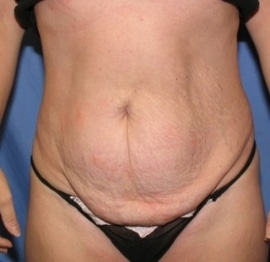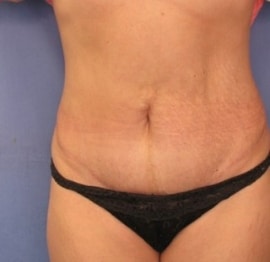A mini tummy tuck is a modification of a tummy tuck; it addresses the “pooch” of the lower abdomen. In some women, the lower abdomen is particularly stretched with pregnancy, causing problems limited to the lower abdomen. A mini tummy tuck is an ideal procedure for these women.


Differences between a Full Tummy Tuck and a Mini Tummy Tuck
- A mini tummy tuck generally has a shorter scar, although this is not always the case. The length of the scar is varied depending on the degree and location of loose skin.
- A mini tummy tuck generally does not address the skin or muscle above the belly button.
- A new belly button is not created in a mini tummy tuck.
- The recovery of a mini tummy tuck is generally easier. A patient is able to walk upright right away.
- Mini tummy tucks is generally cost less than that of a full tummy tuck.
Simulate a mini tummy tuck by pulling the lower abdomen down. If the abdomen improves significantly with that maneuver alone, a mini-abdominoplasty may be indicated. If there is still looseness of the upper abdominal skin or the belly button is unattractive, the patient may require a full tummy tuck to achieve their goals.
How much does a Mini Tummy Tuck cost?
A mini tummy tuck cost varies based on factors such as surgeon experience. The costs can be broken down into:
- Anesthesia Fees
- Facility Fees
- Surgeons fees
As Dr. Yates has an in-office operating suite, the facility fee is minimal. This is cost-saving directly to the patient.
For a list of the costs of additional common procedures performed by Dr. Yates click here.

What anesthesia is used for Mini Tummy Tucks?

Who is a good candidate for a Mini Tummy Tuck?
About one in five patients looking into a tummy tuck are actually better candidates for a mini tummy tuck. The main difference between the two options for abdominal contouring is the amount of skin tightening above the belly button. A mini tummy tuck is limited in upper skin tightening as the surgery is limited to elevation and tightening of the lower abdomen.
Mini tummy tucks is designed for a patient with limited skin laxity and muscle separation primarily below their belly button. Often a mini tuck has a shorter and lower incision, but that’s not necessarily the case. The location of your sagging skin dictates the length of incision Dr. Yates will need to make.
What is recovery like after a Mini Tummy Tuck?
Recovery from a mini tummy tuck isn’t much different than a full tummy tuck except only the lower incision is involved. However, this is a long incision and recovery will limit your ability to engage your abdominal muscles so not to put pressure on your bikini line incision. During the first week or so of your recovery you’ll want to have help around the house. Most patients can return to work in about two weeks, but if your job is physical you could need more time.
The main concern during your recovery is to avoid any lifting of anything over a gallon of milk for four to six weeks. This seems extreme but being kind to your incision means it will be a far less noticeable scar after it heals. Any strenuous exercise needs to wait for six weeks as well.
Your compression garments are also an important part of your recovery. You’ll need to wear your compression garments for two full weeks and maybe longer, depending upon your healing. The compression applied by these garments keeps your swelling down, helps your skin tighten down to your new slimmer contour, and it helps your incision heal cleanly and evenly.
What is the difference between a Tummy Tuck and Liposuction?
Our patients sometimes confuse these two procedures, but they really have little in common beyond both being body contouring procedures.
Liposuction is a less invasive procedure intended to remove pockets of stubborn fat. A thin cannula with suction is inserted through very small incisions to gain access to the unwanted fat. The cannula is moved back and forth to break loose the fat cells and suction them away. Liposuction doesn’t do anything to the skin and muscles in the abdomen.
As described above, a tummy tuck removes excess, sagging skin and often surgically brings separated stomach muscles back together in their original position in the center of the stomach area. Tummy tucks involve either one (mini) long lower incision or that incision along with a second incision around the belly button (full). Tummy tucks have much more involved recoveries and can deliver quite dramatic results. For many tummy tucks, Dr. Yates uses some amount of liposuction to help remove accumulated fat in addition to the excision of excess sagging skin.
Patients who are good candidates for liposuction have little or no loose stomach skin. Their problem is pockets of unwanted fat. They must have good elasticity in their skin, as the skin needs to tighten down over the slimmer contour once Dr. Yates removes the fat. If the patient doesn’t have good skin elasticity, removing the fat with liposuction can actually create more loose skin.
Can a Tummy Tuck be combined with other procedures?
Dr. Yates often includes some amount of liposuction to remove pockets of fat with his tummy tuck procedures. If you want to have liposuction on another area around the hips — the flanks, for example — this could be combined with a tummy tuck. Modern liposuction is easy to recover from, so it won’t exacerbate your recovery much.
A mommy makeover combines a full tummy tuck with liposuction and a breast lift, with or without implants. Patients interested in a mini tuck could be interested in the same combination.
During your consultation with Dr. Yates, you can discuss these possibilities of combining procedures. This approach has the advantage of having only a single recovery for two or more procedures.
Are There Any Risks with a Mini Tummy Tuck?
While a mini tummy tuck is safe and effective, just like any other type of cosmetic surgery, it still comes with several risks that you should be aware of. These risks may include:
- Poor wound healing
- Unexpected scarring
- Fluid accumulation beneath the skin (seroma)
- Tissue damage
- Changes in skin sensation
- Excessive bleeding
- Infection
- Unsatisfactory results
Although these risks are rare, patients undergoing a mini tummy tuck procedure under the care of Dr. York Yates can feel confident knowing their personal safety and comfort will be prioritized. Board-certified by the American Board of Plastic Surgery, Dr. York Yates takes a personalized and careful approach to each procedure, minimizing the risk of complications as much as possible.
How Can I Prepare for My Mini Tummy Tuck Procedure?
Preparing ahead of time for your mini tummy tuck procedure can also prevent complications from occurring during both your surgery and your recovery. To properly prepare for a mini tummy tuck, we encourage you to do the following:
- Consult with your primary doctor to ensure you are healthy enough to undergo and heal from cosmetic surgery.
- Check with your doctor about stopping any prescription medications that may interfere with the success of your surgical procedure and recovery.
- Schedule a consultation with Dr. Yates to ask any outstanding questions you may have about the procedure and to determine your eligibility.
- Quit smoking for at least six weeks before your procedure.
- Avoid medications that can increase bleeding.
- Begin eating a nutritious diet that you can stick to.
- Establish an exercise routine that will help you maintain a stable weight.
How Long Will the Results from a Mini Tummy Tuck Last?
The results from a mini tummy tuck will be permanent. Once excess skin and fat are removed from your body during the mini tummy tuck procedure, there is no chance that the same removed skin will return. However, the results from your mini tummy tuck procedure may change if you were to gain or lose a significant amount of weight suddenly.
To maintain the results from your tummy tuck procedure, you should:
Exercise regularly.
Mini tummy tuck surgeries often focus on toning the abdominal muscles and achieving a slimmer appearance. To maintain this, having a consistent exercise routine will prevent the disappearance of these results. While you benefit from doing exercises that focus on the abdominal muscles, simple aerobic exercises such as walking or jogging consistently will also be just as effective at maintaining your results.
Eat a Healthy Diet.
Eating a healthy diet supports the initial healing process and protects the long-term results of your tummy tuck. During your recovery, a balanced diet rich in lean proteins, fresh fruits, vegetables, and whole grains provides the nutrients your body needs for tissue repair. This type of diet also reduces inflammation to help you heal more efficiently. As time goes on, making nutritious food choices will keep your weight stable. Significant weight gain causes the remaining fat cells in the treated area to grow and distorts the cosmetic outcome of a mini tummy tuck. By prioritizing wholesome foods, you not only enhance your recovery but also enjoy the aesthetic benefits of your tummy tuck for years.
Avoid Pregnancy if Possible.
Although most mini tummy tuck candidates are done having families before undergoing the procedure, some patients may not be. However, if possible, we recommend patients avoid pregnancy after receiving a mini tummy tuck as the bodily changes from being pregnant will affect the appearance of your results.
Can a Mini Tummy Tuck Help Me Lose Weight?
Patients can expect to lose an average of about three pounds during their mini tummy tuck procedure. However, it’s important to note that a mini tummy tuck is not an alternative to weight loss. Mini tummy tuck candidates should be as close to their goal weight as possible to achieve optimal toned, contoured, and balanced results.
How do I schedule a consultation or schedule surgery?
Contact Dr. Yates at 801.525.8741, or fill out an online virtual consult form with any questions you may have. Dr. Yates serves patients from Salt Lake City, Layton and surrounding areas. Call today to schedule an appointment.



